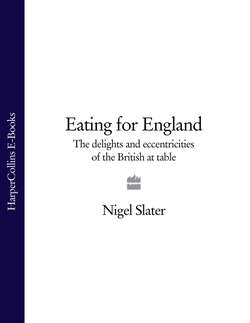Читать книгу Eating for England: The Delights and Eccentricities of the British at Table - Nigel Slater - Страница 39
Frogspawn and Nosebleeds
ОглавлениеThe idea was that you rushed through your main course to get to your ‘afters’, so a pudding that is horrible makes no sense at all. It follows that a pudding, dessert, sweet – whatever you call it – must be nice. Naturally, that disqualifies anything that is sloppy, slimy, gummy, cummy or lumpy. It should go without saying that a pudding shouldn’t make you gag or retch or heave or shudder. So how come we ever got to eat tapioca? Along with those wicked sisters of the school dining room, sago and semolina, it defies the first law of pudding, in that it must be a treat, something you want to eat, and more importantly something you will agree to be good for. Why should anyone want to tidy their room, be nice to their sister, take the dog out, clean out their rabbit’s cage or write Auntie a thank-you letter if their reward is a bowl of snot?
No one else is stupid enough to eat it. Not the French, not even the Germans, for God’s sake.
Rice pudding, on the other hand, is the quintessential nursery food. It is simply breast milk for adults. Introduced to Britain by Saxon invaders – how sweet of them to bring us such comfort with their rape and pillage – the pottage of broth and cereals was at first savoury, then by the seventeenth century developed into a sweet mixture of grain, milk and spices. That such dairy-based delights as tapioca and sago puddings have survived in an age of double choc-chip ice cream and black cherry cheesecake is surely testament to the seductive, soothing and security-giving qualities of warm milk.
The word soothing has been attached to more luxurious things than milk puddings, among them Brahms’s symphonies, cashmere throws and Cadbury’s Flakes. But the genre is still regarded as one of the most successful ways to smooth our ruffled feathers and to make us feel safe and loved. It is also probably the cheapest comfort next to sucking our thumbs.
Puddings of grain, milk and sugar that are cooked in the slowest possible way, usually for three hours or so in a cool oven, seem to belong to a different age. A time when speed was of less interest, where the instant hit of a quick-fix blueberry muffin and a skinny latte was but a distant dream. At first they were sweetened with sherry, cinnamon and sugar, or enriched with eggs. In the eighteenth century they were often covered with a pastry crust – nursery food with knobs on.
Unusually, the modern milk pudding is less rich than its forebears, often being made with nothing but rice, milk and sugar. A long curl of lemon rind or a sprinkling of nutmeg is now seen as an unnecessary addition. A vanilla pod is the only extravagance I put in my own milky puddings, split in half so that some of the fine black seeds escape to freckle the sweet, ivory-coloured milk. Vanilla extract is a cheaper option, but is less subtle. My stepmother always added a bay leaf, until she saw one on Gardener’s World and realised our bay tree was actually an ornamental laurel.
I don’t know anyone who still eats those schoolkid’s nightmares sago or tapioca, though they must have their fans. They carry the nickname ‘frog spawn’ appropriately enough. I have always felt that to be named after amphibians’ eggs was actually far too polite for the grey slime they served up as tapioca at school, and have always had my own, rather more gritty, term for it.
